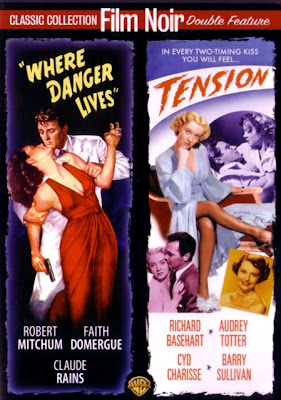WHERE DANGER LIVES/TENSION (RKO 1950/ MGM 1949) Warner Home Video

Warner Home Video unleashes another double dynamo of
noir thrillers, surely to please those who enjoy slick and stylish crime thrillers.
Director John Farrow’s Where Danger Lives (1950) is a bit of brooding
nonsense that pits one of noir’s most iconic leading men, Robert Mitchum
against a heap of trouble, attractively embodied in the hour-glass figure of
Faith Domergue.The screenplay by Charles Bennett is desperately plying the
conventional wisdom of the suspense thriller, though arguably without the
intense scrutiny to know when to use more restraint than pulp to get each plot
point across. The story opens with noble doctor, Jeff Cameron (Mitchum) saving
the life of attempted suicide victim, Margo Lannington (Domergue). Cameron is
sweet on nurse, Julie Dorn (Maureen O’Sullivan) for about thirty seconds, until
Margo’s poisonous venom seeps into his consciousness and thereafter, totally
takes over, consuming his every thought, all logic and good reason. Through a
series of nightclub liaisons, Margo and Jeff become intimate. She confesses –
or rather, lies – to him about the maniacal tendencies of her rich but
controlling husband, Frederick (Claude Rains).
Tragically, Jeff believes Margo’s every word, leading
to a confrontation between him and Frederick at Margo’s stately home. Jeff
accidentally murders Frederick in a brawl but not before Frederick manages to
give Jeff a concussion that will most likely lead to his slipping into a deadly
coma. Margo packs Jeff into her car and together they make a break for the
Mexican border, along the way running into all sorts of blockades that threaten
to send them to prison. For all its wiles, Where Danger Lives isn’t a
particularly engaging entertainment. Mitchum is doing his best drowsy-eyed,
devil-may-care and ‘to hell with the world’ take on life that made him so right
for noir suspense thrillers. But he is hampered by an ineffectual and wildly
inconsistent performance from Faith Domergue - part Audrey Totter/part Jane
Greer – neither wholly convincing. The inimitable Claude Rains is wasted in the
thankless part of the bitter hubby come corpse. Still, there is Nicholas
Musuracas’ cinematography to revel in, as well as Eda Warren’s swift editing of
the chase sequences. These add a spark of brilliance to the proceedings.
Much more satisfying on every level is director John
Berry’s B-movie, Tension (1949), an acidic and capable minor nail-biter
that stars the now largely forgotten, Richard Basehart as Warren Quimby. Warren
is a milquetoast pharmacist doing his best to live up to the impossible
expectations of his sexually ruthless and utterly emasculating wife, Claire
(Audrey Totter). It seems Claire wants it all: danger, sex and money – none of
which Warren is able to provide. Hooking up with tough guy, Barney Deager
(Lloyd Gough), Claire leaves Warren for Barney’s beach house only to be tailed
by Warren. In the resulting confrontation, Barney beats Warren to a pulp,
leaving Warren with just one option - to plot Barney’s murder. Adopting the
name Paul Sothern, Warren moves into a nearby seaside apartment where he meets
aspiring photographer, Mary Chandler (Cyd Charisse). After breaking into
Barney’s beach house, Warren has second thoughts about killing him. Instead, he
holds a sharp poker to Barney’s throat until Barney wakes up – then, confronts
Barney with a twofold revelation. First,
Claire is likely out on the prowl for her next meal ticket, and second, all of
Barney’s brute strength is for not against Warren’s cunning, led into this
moment where he could so easily stab Barney to death if he so chooses.
Leaving Barney to contemplate his own insignificance,
Warren returns to Mary to pursue a romantic relationship. But Claire has other
ideas – especially since she has just murdered Barney herself and plans to pin
the crime on Warren to escape prosecution. But neither Warren nor Claire reason
on the astute powers of deduction of Police Ltn. Collier Bonnabel (Barry
Sullivan). Pitting Claire and Warren against one another and revealing to Mary,
Warren’s true identity, Collier pulls no punches in coaxing an inevitable
confession from the guilty party. Tension is nail-biting good fun. Its
cast work at top speed to ensure finely wrought performances throughout.
Basehart is a natural at this sort of characterization; as proven by his other outstanding
turns in such noir classics as Fourteen Hours and The House on
Telegraph Hill (both in 1951). In Tension, Basehart successfully walks
a tightrope between Egbert chemist and suave traveling salesman – the henpecked
hubby eventually giving way to a manlier mate for the voluptuous Mary. Totter
is perfection too, the very embodiment of sinful repulsiveness. Barry Sullivan
makes a winning detective. It’s a wonder he never did more sleuthing in other
movies or on television. In the final analysis, Tension generates plenty
of it with a fitting conclusion to boot.
Warner Home Video has housed both films on a single-sided
disc. Nevertheless, image quality does not seem to have been compromised. Both
films exhibit similar tonality, sharpness and clarity with Tension marginally
crisper than Where Danger Lives. The gray scale on each is well
balanced. Fine details are generally evident. Age-related artifacts are
prominent on Where Danger Lives than Tension. Both transfers
exhibit several lapses in overall sharpness with more than an acceptable amount
of film grain evident in several scenes. Minor edge enhancement and shimmering
of fine details is also evident throughout both features. The audio is mono as
original recorded and quite adequate for both presentations. In addition to
providing two separate and comprehensive audio commentaries (one for each film)
Warner Home Video also provides us with two featurettes in which various noir
historians briefly wax about the finer points of the genre in general and each movie
in particular. Theatrical trailers are also included. Recommended!
FILM RATING (out of 5 - 5 being the best)
Where Danger Lives 3
Tension 4
VIDEO/AUDIO
3.5
EXTRAS
1.5


Comments